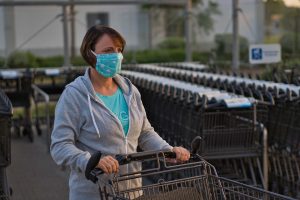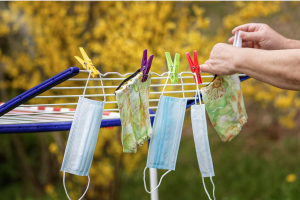13
Kierstyn Stevens
Introduction
The COVID-19 pandemic has caused much unrest and many changes to the world as we knew it. We are living in a reformed society, whether we like it or not. Due to the COVID-19 pandemic, new social norms such as disclosure of personal health information and new standard safety measures have come about and will continue to exist post-pandemic, especially in the university environment.
Connection to STS Theory
This chapter relates to the social constructivism theory, which states that the foundations of human standards are socially situated and constructed through interactions with others. Otherwise known as norms, these new standards that were found due to COVID-19 can be supported by facts yet have spread/become norms due to the general populations’ understanding of the severity and potential the virus has. In many ways, society has adapted to the preventative procedures that are required to maintain the safety and health of one another. These adaptions came about strictly for the sake of the public during the COVID-19 pandemic, but some are perhaps here to stay.
Disclosure of Personal Health & Information
Personal health and information have become more public due to explanations of not gathering, contact tracing, and more. Clemson University has even made it a procedure that students receive a COVID test and have a negative result to enter campus buildings. Apple released a COVID-19 tracking app that, if turned on, allows notifications of exposure. Melanie Padgett Powers, from The Nation’s Health, writes, “Perfecting a surveillance system using apps can benefit contact tracing for other communicable diseases, such as TB and STIs, as well as future virus outbreaks, Bender said,” (Powers, 2020). It is stated that this tracking is optional and only functional if turned on. While U.S. students are subject to random testing and providing proof that they are negative, other countries live in similar situations of making their information more public. Uri Friedman, an editor, and writer at The Atlantic, talks about his friends’ experiences with a post-COVID (low levels) environment. Documents must be carried around with them stating they have been tested and were negative before using things like taxis and entering restaurants (Friedman, 2020).

The shutdown of public places in the U.S. led to a drastic increase in unemployment claims, whether it was due to being laid off for budget cuts or staying home from work due to underlying medical conditions. The New York Times reported that more than 36 million claimed unemployment in a 2 month span from April to June (Cohen & Hsu, 2020). To reason refraining from going to work, employees had to inform their superiors of personal and even familial health issues. Friends and family have to explain themselves as well. Underlying issues like asthma, diabetes, and a range of illnesses are restricting people from meeting with friends, going to work or school, and even going out to the grocery store. From social to educational to working environments, personal information has become a common topic of discussion and, therefore, public knowledge. Making personal and familial health information public is a new norm that will likely persist post-pandemic.
Voices of Clemson Undergraduate Students
“Personally, I’ve had to explain myself, in this college environment, more times than I can count.”
Standard Safety Measures: New Norms

Our life has been altered in many ways, and not everybody has handled the changes well. The World Health Organization has uploaded infographics for printing to spread the norms of masks, distancing, washing, and sanitizing hands, avoiding touching your face, and isolation. Clemson University, restaurants, stores, and everywhere have similar flyers on their doors and signs. It is nearly impossible to forget the 6-foot rule, not touch your face, wash your hands, and wear a mask. However, this mask mandate has not been accepted easily. Protests of masks have popped up across the country. According to a Forbes article, people have been quoted saying the virus is a hoax and a political stunt and that they will not be forced to wear a mask (Beer, 2020). Many videos have gone viral of workers requesting anti-maskers to wear a mask in their store, resulting in yelling and stating that this is against their rights. This is not the first instance of change going wrong, though. In Society and technological change (5th ed.), in the nineteenth century, an outbreak of machine-smashing occurred in England (Volti, 2006). Though this technology they were smashing created more products for the public, not all people accepted this new way because the textile workers had less business and sales. Similarly, the mask mandate benefits the general public and U.S. by limiting the spread of COVID-19. However, people ignore the mask mandate and other rules for personal reasons. One way of avoiding all of these rules is to stay inside and go online. Nancy R. Gough, PhD talks about education, work, and socializing taking an online format, which could continue for a while. Some universities have gone entirely online for the fall 2020 semester. Many jobs have turned to an online and work-from-home style, if possible (Gough, 2020). Due to this surge of online school and career work, online video chatting software like Zoom and Microsoft Teams have become almost necessary parts of life. With COVID-19, many changes and new norms have come about and will continue after the pandemic is gone.
Our Future Post-COVID-19
Our future life is very dependent on the pandemic right now, but how will it look? With COVID surging at different times around the world, Friedman points out that it is happening asynchronously. He tells of his friend living in Wuhan, China. In leaving his complex, he gets his temperature taken and written down on a card. He has to use that card to go anywhere, such as restaurants or to take a taxi, and continues to wear a mask about the city. He says that city life is nowhere near as bustling as it used to be, and many restaurants have shut down or resorted to outdoor and takeout only (Friedman, 2020). But that is how Wuhan is handling it. Every place will be different. Jeff Grabmeier of Ohio State News talks about David Staley, an associate professor at Ohio State, and what he believes will prevail post-pandemic in the U.S. Personal space norms, virtual meetings, reformed sporting and concert events, and workers’ rights are likely to change (Grabmeier, 2020). We will probably continue to wear a mask for a while, whether due to cases or personal preference. People have already begun to try to return to the old normal in terms of social gatherings, especially college students. At Clemson University, the community saw a spike in cases from about 500 around August 15, 2020, when students began to move into off-campus housing, to about 2500+ a month later (The New York Times, 2020) and lead U.S. colleges in the number of cases as of October 28, 2020 (Mitchell, 2020). Though working as a community to stop the spread would help, it is an optimistic idea that will not happen. The best way this pandemic could be diminished is with a vaccine. But without it, the world continues on this path of the unknown. What is known is that the pandemic will directly impact the future in uncountable ways.
Conclusion
With news, cases, and facts updating and changing daily, the future is still in question. We will see a change in our own habits, whether sanitizing, distancing, or even continuing to wear a mask post-pandemic. But when is the main component of that question. And that is unknown until the time comes.
Supplementary Materials
VirusBreak by Bioinformatics – A virus outbreak simulator
References
Beer, T. (2020, July 16). Anti-Mask Rallies Continue In U.S. Amid Rising Coronavirus Cases And Deaths. Forbes. https://www.forbes.com/sites/tommybeer/2020/07/16/anti-mask-rallies-continue-in-us-amid-rising-coronavirus-cases-and-deaths/?sh=51077d742246.
Cohen, P., & Hsu, T. (2020, May 14). ‘Rolling Shock’ as Job Losses Mount Even With Reopenings. The New York Times. https://www.nytimes.com/2020/05/14/business/economy/coronavirus-unemployment-claims.html.
Friedman, U. (2020, May 4). I Have Seen the Future-And It’s Not the Life We Knew. The Atlantic. https://www.theatlantic.com/politics/archive/2020/05/life-after-coronavirus-china-denmark-south-korea/611011/.
Gough, N. R. (2020, April 26). The New Normal Is Life with COVID-19. Medium. https://ngough-bioserendipity.medium.com/the-new-normal-is-life-with-covid-19-9c1b3aa1fe72.
Grabmeier, J. (2020, September 21). Four ways life may be different after COVID-19. https://news.osu.edu/four-ways-life-may-be-different-after-covid-19/.
Mitchell, A. B. (2020, October 28). Clemson likely leads US colleges in COVID cases. Required testing, tracing slows spread. Post and Courier. https://www.postandcourier.com/greenville/health/clemson-likely-leads-us-colleges-in-covid-cases-required-testing-tracing-slows-spread/article_db3dfa0e-0ff0-11eb-9e7b-439f1a04959e.html.
Powers, M. P. (2020, July 1). How will COVID-19 reshape future of US public health? Field expected to evolve post-pandemic. The Nation’s Health. https://thenationshealth.aphapublications.org/content/50/5/1.3.
The New York Times. (2020, April 1). South Carolina Covid Map and Case Count. The New York Times. https://www.nytimes.com/interactive/2020/us/south-carolina-coronavirus-cases.html.
Volti, R. (2006). Chapter 2: Winners and Losers: The Differential Effects of Technological Change. In Society and technological change (5th ed.). Worth Publishers. p. 17-31.
Images
Image 1: “Mouth Guard Infection” by Anrita1705 is licensed under CC BY 4.0
